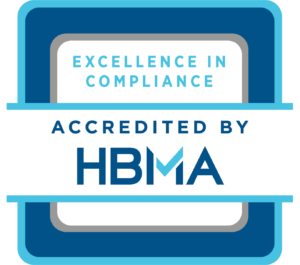An effective SOP will ensure consistency, compliance, & efficiency
Creating a Standard Operating Procedure (SOP) for the healthcare revenue cycle involves detailing each phase of managing the financial and administrative aspects of patient care from registration through payment collection. The healthcare revenue cycle is complex, involving multiple departments and systems, so an effective SOP will ensure consistency, compliance, and efficiency.
Steps to create a revenue cycle SOP
- Objective: Ensure accurate and efficient management of the healthcare revenue cycle to maximize revenue, reduce denials, and maintain regulatory compliance.
- Scope: Identify which departments are involved (e.g., patient access, billing, coding, claims management, collections, etc.).
- Target Audience: Revenue cycle staff including front office (registration), billing, coders, accounts receivable staff, and collections team.
- Specify all necessary software and systems:
- Electronic Health Record (EHR) systems: EPIC, Cerner, athenahealth, Veradigm, eClinicalWorks, etc.
- Practice management systems: NextGen, Kareo, etc.
- Coding software: for ICD-10, CPT, and HCPCS.
- Workforce automation software: tracking and measuring RCM staff efficiency
- Robotic process automations (RPA): technology to automate previously manual tasks
- List resources for eligibility checks, claim submissions (e.g., payer portals), and compliance (e.g., HIPAA regulations, payer guidelines).
The SOP should be structured around key stages in the healthcare revenue cycle. Each section should outline the steps involved, roles, and required documentation.
3.1 Patient Registration and Pre-Authorization
- Registration: Define the process for collecting and verifying patient demographic information, insurance details, and contact information.
- Eligibility Verification: Step-by-step guide on using payer portals or clearinghouses to confirm insurance eligibility and benefits (copays, deductibles).
- Pre-authorization: Detail the procedure for obtaining pre-authorization or pre-certification from insurers for certain services.
- Document retention: Specify which forms (e.g., insurance cards, ID) must be retained and how.
3.2 Charge Capture
- Define how healthcare services provided are recorded accurately in the system (e.g., physician’s notes translated into billable codes).
- Coding: Ensure correct coding of procedures (CPT), diagnoses (ICD-10), and other services.
- Provide guidelines for coders to avoid upcoding or downcoding.
3.3 Claims Submission
- Claim creation: Outline the process of generating and validating claims through the practice management system.
- Claim submission: Instructions on submitting claims electronically (EDI) or manually to insurance payers.
- Include timely filing deadlines for different insurers and ensure adherence to payer-specific submission rules.
3.4 Payment Posting
- Describe the process for posting payments from insurance companies, patients, or third-party payers.
- Detail how to match Explanation of Benefits (EOBs) or remittance advice (RA) with billed services.
- Procedures for handling underpayments, overpayments, and payment denials.
3.5 Denial Management
- Define the workflow for identifying, reviewing, and addressing claim denials or rejections.
- Establish timelines for response and resubmission of denied claims.
- Include specific steps for correcting errors, missing information, and other reasons for denials (e.g., lack of medical necessity).
3.6 Accounts Receivable (AR) Management
- Define the AR aging process and describe how to manage outstanding balances.
- Outline the follow-up process for unpaid claims and bills, including communication with insurance payers and patients.
- Detail the escalation process for long-outstanding accounts.
3.7 Patient Billing and Collections
- Define procedures for generating and sending patient bills (e.g., after insurance payment).
- Describe how to set up payment plans for patients with high out-of-pocket costs.
- Guidelines for collections and third-party collection agencies when bills remain unpaid.
Clearly define responsibilities for each phase:
- Registration clerks: Collect patient information and verify insurance.
- Coders: Ensure correct and compliant coding for billing.
Billing staff: Create and submit claims, manage payment posting. - Accounts Receivable (AR) team: Manage aging claims and payment follow-ups.
- Denial management team: Rework denied claims and resubmit them.
- Collections officers: Manage unpaid accounts and coordinate with collection agencies when necessary.
- Ensure that every part of the revenue cycle adheres to regulations such as:
- HIPAA: Protect patient privacy when handling billing information.
- False Claims Act: Prevent fraudulent claims submissions.
- CMS Regulations: If dealing with Medicare/Medicaid, follow CMS billing guidelines.
- Detail steps to ensure that all protected health information (PHI) is securely managed and shared only with authorized parties.
Identify measurable outcomes for monitoring the effectiveness of the revenue cycle process:
- Days in Accounts Receivable (AR): Measure how long it takes to collect payments.
- Clean Claim Rate: Percentage of claims accepted upon first submission.
- Denial Rate: Percentage of claims denied or rejected.
- Cash Collections as a Percentage of Net Revenue.
- Patient Satisfaction: Monitor feedback regarding billing and financial interactions.
Identify measurable outcomes for monitoring the effectiveness of the revenue cycle process:
- Days in Accounts Receivable (AR): Measure how long it takes to collect payments.
- Clean Claim Rate: Percentage of claims accepted upon first submission.
- Denial Rate: Percentage of claims denied or rejected.
- Cash Collections as a Percentage of Net Revenue.
- Patient Satisfaction: Monitor feedback regarding billing and financial interactions.
- Schedule regular internal audits to ensure adherence to SOPs and identify areas for improvement.
- Outline procedures for reporting and correcting errors (e.g., coding mistakes or billing inaccuracies).
- Establish a review cycle for updating the SOP based on regulatory changes, payer requirements, or internal process adjustments.
- Outline the training process for new hires in the revenue cycle, including necessary certifications (e.g., Certified Professional Coder, CPC).
- Provide ongoing training on regulatory updates and system changes (e.g., new billing codes).
- Define a troubleshooting guide for common problems such as claim rejections, billing software issues, and denied payments.
- Include steps for escalating unresolved issues to department managers or compliance officers.
- Identify who is responsible for reviewing and updating the SOP (e.g., Revenue Cycle Manager, Compliance Officer).
- Outline the approval process for changes to the SOP.
Sample SOP Outline for Healthcare Revenue Cycle
Title: Standard Operating Procedure for Revenue Cycle Management
Version: 1.0
Effective Date: [Insert Date]
Review Date: [Insert Date]
Prepared by: [Name/Position]
Approved by: [Name/Position]
Section 1: Purpose
Section 2: Scope
Section 3: Roles and Responsibilities
Section 4: Tools and Systems
Section 5: Step-by-Step Procedures
5.1 Patient Registration and Pre-authorization
5.2 Charge Capture
5.3 Claims Submission
5.4 Payment Posting
5.5 Denial Management
5.6 Accounts Receivable Management
5.7 Patient Billing and Collections
Section 6: Compliance and Regulations
Section 7: KPIs and Performance Monitoring
Section 8: Auditing and Continuous Improvement
Section 9: Training
Section 10: Escalation and Troubleshooting
Section 11: Review and Approval
This structure will help ensure that your healthcare revenue cycle operates smoothly, minimizes errors, and maximizes reimbursement from both insurance payers and patients. Regular reviews and updates are essential to keep the SOP compliant with regulatory changes and evolving industry standards.










